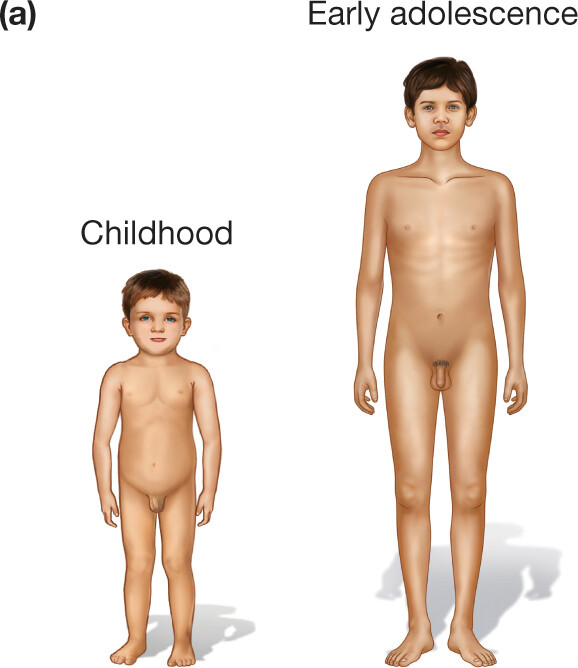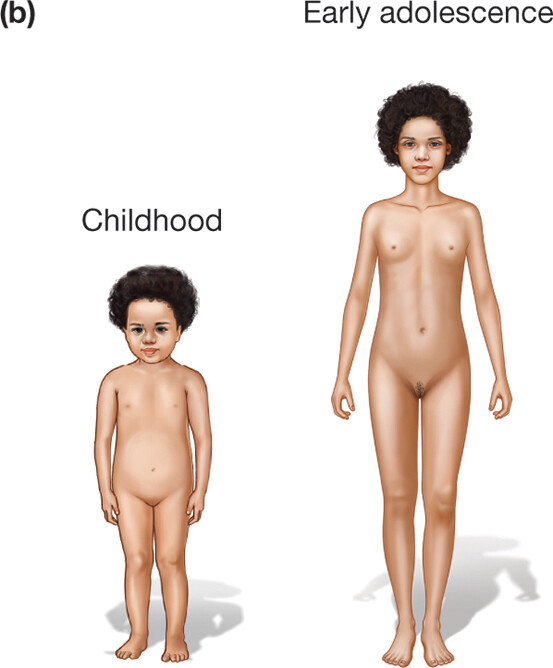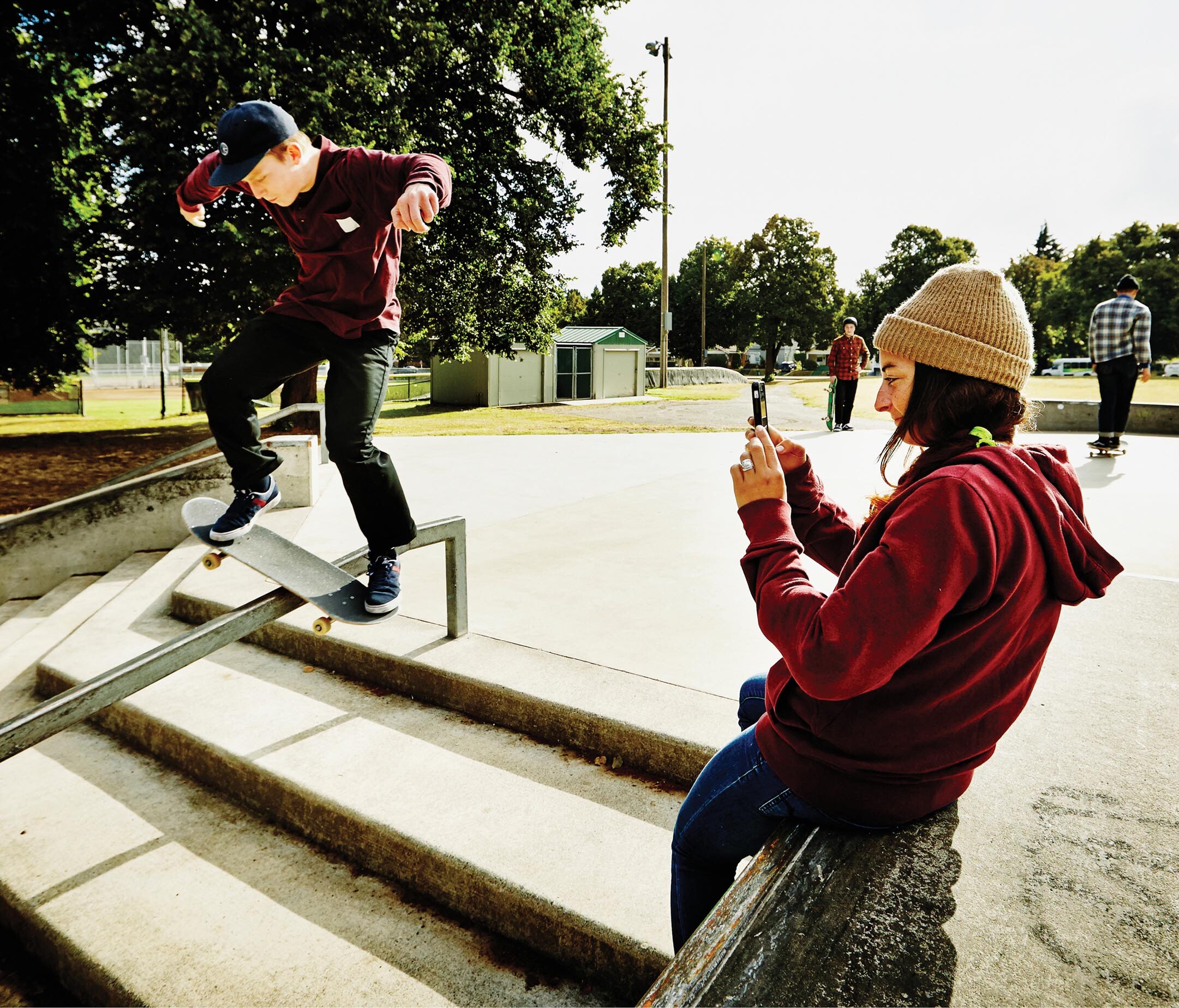LEARNING GOAL
Explain how the body and the brain change during adolescence.
LEARNING GOAL
Explain how the body and the brain change during adolescence.
Physically, adolescence is characterized by the onset of sexual maturity and the ability to reproduce. Puberty, a developmental period in which sexual maturation leads to the ability to reproduce, marks the beginning of adolescence. The first signs of puberty typically begin at about age 8 for girls and at about age 9 or 10 for boys. Most girls complete pubertal development by age 16 (Ge et al., 2007; Herman-Giddens et al., 2001; Sun et al., 2005), and boys finish by age 18 (Lee, 1980).
Puberty When you were around 10 or 12 years old, did you seem to grow overnight? This adolescent growth spurt—a rapid, hormonally driven increase in height and weight—is an obvious dividing line between childhood and puberty. During puberty, hormone levels increase throughout the body, stimulating many physical changes that allow us to develop into sexually mature adults.
The first changes that occur are the development of the secondary sex characteristics, which are physical features that are not directly related to reproduction (Figure 4.21). Boys and girls start to experience greater growth of body hair, first as darker and thicker hair on the legs, then hair under the arms, then pubic hair (Marshall & Tanner, 1970), then hair in other places. Boys’ muscle mass increases, their voices deepen, and their jaws become more angular. Girls lose baby fat on their bellies as their waists become more defined, and they also develop fat deposits on the hips and breasts (Lee, 1980). You will learn more about puberty, and how these changes affect adolescents’ sexual desires, in Chapter 10.

The illustration shows a small naked boy with the word Childhood above him. Next to him is another naked boy with the words Early adolescence above him. The early adolescent is bigger than the child overall.

The illustration shows a small naked girl with the word Childhood above her. Next to her is another naked girl with the words Early adolescence above her. The early adolescent is bigger than the child overall.
FIGURE 4.21 Physical Development During Adolescence
These drawings show that early adolescents develop secondary sex characteristics during puberty that change them from looking like children to looking more like adults. (a) Boys begin to develop darker and thicker body hair on the legs, in the armpits, and in the pubic area. They grow taller and begin to gain muscle mass. (b) Girls begin to develop darker and thicker body hair on the legs, in the armpits, and in the pubic area. They become taller and grow breasts.
Puberty also brings the maturation of the primary sex characteristics, which are physical features directly involved in reproduction. During puberty, the male and female external genitals and internal sex organs mature, menstruation begins in girls, and boys begin to produce sperm. These physical changes result in adolescents becoming sexually mature and able to reproduce.
Puberty may seem to be purely physical, but it is affected by environment. For example, a girl who lives in a stressful environment or has insecure attachments to caregivers is likely to begin menstruating earlier than a girl who lives in a peaceful, secure environment (Wierson et al., 1993). This finding suggests that a girl’s body responds to stress as a threat. Because the body feels threatened, it speeds up the ability to reproduce in order to pass along the girl’s genes to the next generation. Thus environmental forces trigger hormonal changes, which send the girl into puberty (Belsky et al., 2010). Because boys do not have an easily identifiable pubertal event like menstruation in girls, we know less about the effects of environment on puberty in boys. Boys and girls experience similar changes in brain development during adolescence, however, so researchers are able to identify a few key characteristics of the teenage brain.

FIGURE 4.22 Adolescent Risk Behavior
Adolescents engage in impulsive and risky behaviors in part because the frontal lobes develop more slowly than limbic motivational regions involved in reward.
Brain Changes During Adolescence While teenagers are experiencing pubertal changes, their brains also are in an important phase of reorganization. Synaptic connections between neurons are strengthening. The development of the frontal lobes is involved in how adolescents come to understand themselves and how they understand others (Crone & Fuligni, 2020). However, the frontal cortex of the brain is not fully developed until the mid-20s (Sawyer et al., 2018; Somerville, 2016). An adolescent’s limbic system—that is, the motivational and emotional center of the brain—tends to be more active than the frontal cortex. As a result, although teenagers are able to think critically, they often have a difficult time doing so. Instead, they are more likely to act impulsively and engage in risky behaviors than adults are (Figure 4.22; Blakemore & Choudhury, 2006; Casey et al., 2011). For instance, they might give in to strong temptations because their frontal cortex cannot override their desires (Cohen & Casey, 2017). Because teenagers have the ability to understand behavioral consequences, it is important to help them learn about the consequences of their own actions. If parents, teachers, community members, and other adults are supportive and provide the proper guidance and discipline, adolescents will know that people who care about them will help them develop good decision-making skills (Steinberg & Morris, 2001).
An ambitious ongoing study is tracking brain development from childhood to early adulthood in nearly 12,000 Americans. Launched in 2016 by the National Institutes of Health, the Adolescent Brain Cognitive Development (ABCD) study has already produced findings related to cognitive, behavioral, and mental health outcomes (Compton et al., 2019). For instance, researchers have found that adolescents’ screen time is related to differences in brain structures associated with vision and cognitive control (Paulus et al., 2019). Another study revealed that children who were exposed to alcohol during prenatal development were more likely themselves to try alcohol at an early age (Lees et al., 2020). The ABCD study is likely to provide important insights into many aspects of adolescent brain development over the next decade (Volkow et al., 2018).
LEARNING GOAL CHECK: REVIEW & APPLY